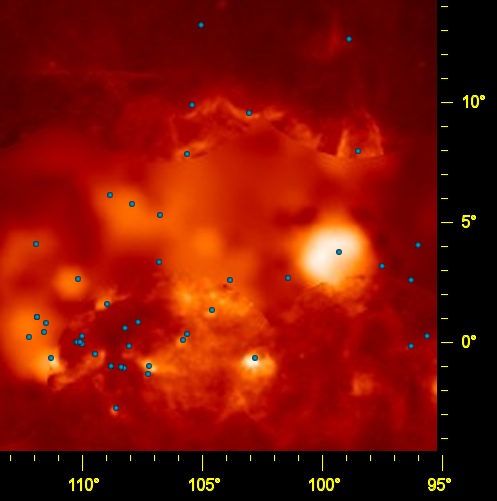
Hover your mouse over each blue dot for the name of the object, or click on the dot for a detail page. This map was created using the all-sky hydrogen-alpha map produced by Douglas Finkbeiner from data collected by the WHAM, VTSS and SHASSA hydrogen-alpha surveys.
The brightest nebula is Sh 2-131, at a distance of 860 parsecs, which surrounds the star cluster IC 1396 and lies at the heart of the Cepheus bubble, the giant expanding shell of gas and dust around the Cepheus OB2 association. Sh 2-133, Sh 2-134, Sh 2-129 and Sh 2-140 are all part of a chain of ionised arcs in the outer reaches of the Cepheus bubble. Sh 2-145, Sh 2-150, Sh 2-154 and the Cave nebula (Sh 2-155) also lie at about the same distance and direction.
A bit closer to us at 600 parsecs is Sh 2-137 and a faint nebula (Sh 2-130) surrounding the runaway B5-class star HD 197911, which was blasted from the heart of the Cepheus OB2 association by a supernova explosion 2-3 million years ago. Even closer, at 450 parsecs, is the Bok globule Sh 2-136.
The Cassiopeia arc actually stretches into the constellation Cepheus. Cepheus OB5 is associated with Sh 2-135, which is ionised by an O9.5V class star and located at a distance of 1900 parsecs. The largest OB association in the arc of Cassiopeia associations is Cepheus OB1. Nebulae associated with Cepheus OB1 include Sh 2-132, giant HII region ionised by two Wolf-Rayet and several OB stars at 3200 parsecs, and and Sh 2-142, the beautiful nebula entwined with the star cluster NGC 7380 at 3500 parsecs. Surprisingly, the distinctive Sh 2-142 does not appear to have a common name - its scalloped curves suggest that the "Clamshell nebula" might be appropriate. Just behind Cepheus OB1 lie Sh 2-143 and Sh 2-138, which contains a large star cluster resembling the Orion Trapezium cluster: it is centrally peaked around several massive stars, and is dense - more than 550 stars at its centre.
Sh 2-157, a ring nebula, and Sh 2-158, a major star formation region, are both part of the Cassiopeia OB2 association at 2500 and 2800 parsecs respectively.
Just to the right of Cassiopeia OB2 are a number of nebulae that seem to be associated with a huge molecular cloud complex located at a distance of about 3800 to at least 5200 parsecs. Sh 2-147, Sh 2-148, Sh 2-149, Sh 2-152, and Sh 2-153 are all parts of the same molecular cloud. Sh 2-146, BFS 12 and Sh 2-156 are nearby. At the beginning of this huge complex lies the Bubble nebula (Sh 2-162) and the nearby Sh 2-163 at 3800 parsecs, as well as the diffuse nebula BFS 14 and the tiny nearby nebulae BFS 16, BFS 17 and BFS 18, all at 4200 parsecs.
The distances to the objects in this molecular cloud complex are from many different sources. Nevertheless, its existence is in some doubt. In their article, The Equilibrium State of Molecular Regions in the Outer Galaxy, describing a large catalog of ten thousand molecular clouds from the Five College Radio Astronomy Observatory Outer Galaxy Survey, Heyer, Carpenter and Snell point out:
The gas in the outer Galaxy is known to exhibit large deviations from circular motions (Brand & Blitz 1993). For example, the IC 1805 OB cluster has a spectroscopic distance of 2.35 kpc, which corresponds to a circular velocity of -20 km/s. The bulk of the CO emission occurs at VLSR of -40 to -50 km/s with a kinematic distance of 4-5 kpc. Such discrepancies have been attributed to streaming motions of the gas in response to the spiral potential or a triaxial spheroid (Blitz & Spergel 1991). In the Survey field, kinematic distances can be larger than the spectroscopic distances by factors of 2.
In other words, molecular clouds in this region may appear to be twice as far as they actually are.
A recent paper, A New Distance Technique for Galactic Plane Objects (Foster and Routledge 2003), uses a new technique to derive distances for some of the above mentioned nebulae, and finds that Sh 2-152 is at a distance of 2800 parsecs, Sh 2-156 is at 2600 parsecs, Sh 2-162 is at 2500 parsecs and Sh 2-163 at 2600 parsecs. If this is true, this suggests that many and possibly all of the objects that are apparently at a distance of about 4-5000 parsecs in this region are in fact streaming gas in the Cassiopeia arc.
Further away than any of these nebulae are Sh 2-127 and Sh 2-128 at 9400 parsecs. The same paper mentioned above (Foster and Routledge 2003) derives new distance estimates for Sh 2-127 (6000 parsecs) and Sh 2-128 (4800 parsecs). While considerably closer, these estimates still place these nebulae well behind the Cassiopeia arc.
